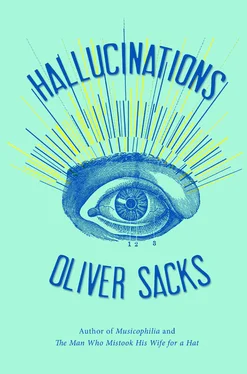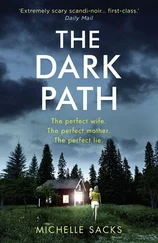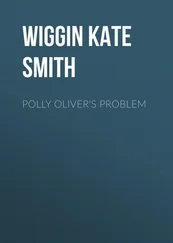Unlike Rosalie, Lullin still had some eyesight left, and his hallucinations were superimposed on what he saw in the real world. Draaisma summarized Lullin’s account:
In February 1758, strange objects had begun to float into his field of vision. It started with something that resembled a blue handkerchief, with a small yellow circle in each corner.… The handkerchief followed the movement of his eyes: whether he was looking at a wall, his bed, or a tapestry, the handkerchief blocked out all the ordinary objects in his room. Lullin was perfectly lucid and at no time did he believe that there really was a blue handkerchief floating around.…
One day in August two granddaughters came to see him. Lullin was sitting in his armchair opposite the mantelpiece, and his visitors were to his right. From the left, two young men appeared. They were wearing magnificent cloaks, red and grey, and their hats were trimmed with silver. “What handsome gentlemen you’ve brought with you! Why didn’t you tell me they were coming?” But the young ladies swore that they saw no one. Like the handkerchief, the images of the two men dissolved within a few moments. They were followed by many more imaginary visitors in the next few weeks, all of them women; they were beautifully coifed and several of them had a small box on their head.…
Somewhat later Lullin was standing at the window when he saw a carriage approaching. It came to a halt at his neighbour’s house and, as he watched in amazement, the carriage grew bigger and bigger until it was level with the eaves of the house some thirty feet from the ground, with everything perfectly in proportion.… Lullin was amazed by the variety of images he saw: one time it was a swarm of specks that suddenly turned into a flight of pigeons, another time a group of dancing butterflies. Once he saw a rotating wheel floating in the air, the kind you saw in dockside cranes. On a stroll through the town he stopped to admire an enormous scaffolding, and when he arrived home he saw the same scaffolding standing in the living room, but then in miniature, less than a foot high.
As Lullin found, the hallucinations of CBS would come and go; his lasted for some months and then disappeared for good.
In Rosalie’s case, the hallucinations subsided within a few days, as mysteriously as they had appeared. Almost a year later, though, I got another phone call from the nurses, telling me that she was “in a terrible state.” Rosalie’s first words when she saw me were “All of a sudden, out of a clear blue sky, the Charles Bonnet has come back with a vengeance.” She described how a few days before, “figures started to walk around; the room seemed to crowd up. The walls turned into large gates; hundreds of people started to pour in. The women were dolled up, had beautiful green hats, gold-trimmed furs, but the men were terrifying — big, menacing, disreputable, disheveled, their lips moving as if they were talking.”
In that moment, the visions seemed absolutely real to Rosalie. She had all but forgotten that she had Charles Bonnet syndrome. She told me, “I was so frightened that I screamed and screamed, ‘Get them out of my room, open those gates! Get them out! Then shut the gates!’ ” She heard a nurse say of her, “She is not in her right mind.”
Now, three days later, Rosalie said to me, “I think I know what triggered it again.” She went on to say that she had had a highly stressful, exhausting time earlier in the week — a long, hot journey to see a gastrointestinal specialist on Long Island and a nasty fall backwards on the way. She arrived back many hours later, shocked, dehydrated, in a state of near collapse. She was put to bed and fell into a deep sleep. She awoke the next morning to the terrifying visions of people bursting through the walls of her room, which lasted for thirty-six hours. Then she started to feel somewhat better and recovered her insight into what was happening. At that point, she instructed a young volunteer to track down an account of Charles Bonnet syndrome on the internet and to give copies of this to the nursing home staff, so that they would know what had been going on.
Over the next few days, her visions grew much fainter and ceased altogether when she was talking with others or listening to music. Her hallucinations had become “shyer,” she said, and now occurred only in the evening, if she sat quietly. I thought of the passage in Remembrance of Things Past where Proust speaks of the church bells of Combray, how their sound seemed muted in the daytime, only to be heard when the hubbub and blare of the day had died down.
Charles Bonnet syndrome was considered rare before 1990 — there were only a handful of case histories in the medical literature. 5 5 Or so it would seem. Recently I came across a marvelous 1845 report by Truman Abell, a physician who started to lose his sight in his fifty-ninth year and had become totally blind by 1842, four years later. He described this in an article for the Boston Medical and Surgical Journal . “In this situation,” he wrote, “I often dreamed of having my sight restored, and of seeing the most beautiful landscapes. At length these landscapes began to appear in miniature when awake : small fields, a few feet square, would appear, clothed with green grass, and other vegetables, some in bloom. These would continue two or three minutes, and then disappear.” The landscapes were followed by an immense variety of other “illusions” — Abell did not use the word “hallucinations” — provided by “an internal sight.” Over the course of several months, his visions increased in complexity. His “silent, but impudent visitors” were sometimes intrusive, with three or four people who would sit on his bed or “come to my bed-side, stoop down over me, and look directly into my eyes.” (Often his hallucinatory people seemed to acknowledge him, although CBS hallucinations typically do not interact with their hallucinators.) One night, he reported, “I was threatened to be run over about 10 o’clock by a drove of oxen; but having my presence of mind, I sat quiet, and with much crowding they all passed without touching me.” Sometimes he saw ranks of thousands of people, splendidly dressed, forming columns that disappeared into the distance. At one point he saw “a column at least half a mile wide” of “men on horseback riding towards the west.… They continued to pass for several hours.” “What I have here stated,” Abell wrote at the end of his detailed account, “must appear incredible to those unacquainted with the history of illusive visions.… How far my blindness contributed to produce such a result, I am not able to say. Never before have I been able to realize the ancient comparison of the human mind to a microcosm, or universe in miniature … [yet] the whole was confined within the organ of mental vision, and occupied, perhaps, a space of less than the tenth part of an inch square.”
I thought this strange, for working in old-age homes and nursing homes for over thirty years, I had seen a number of blind or purblind patients with complex visual hallucinations of the Charles Bonnet type (just as I had seen a number of deaf or nearly deaf patients with auditory — and most often musical — hallucinations). I wondered whether CBS was actually much commoner than the literature seemed to indicate. Recent studies have confirmed that this is the case, although CBS is still little recognized, even by doctors, and there is much to suggest that many or most cases are overlooked or misdiagnosed. Robert Teunisse and his colleagues, studying a population of nearly six hundred elderly patients with visual problems in Holland, found that almost 15 percent of them had complex hallucinations — of people, animals, or scenes — and as many as 80 percent had simple hallucinations — shapes and colors, sometimes patterns, but not formed images or scenes.
Читать дальше












